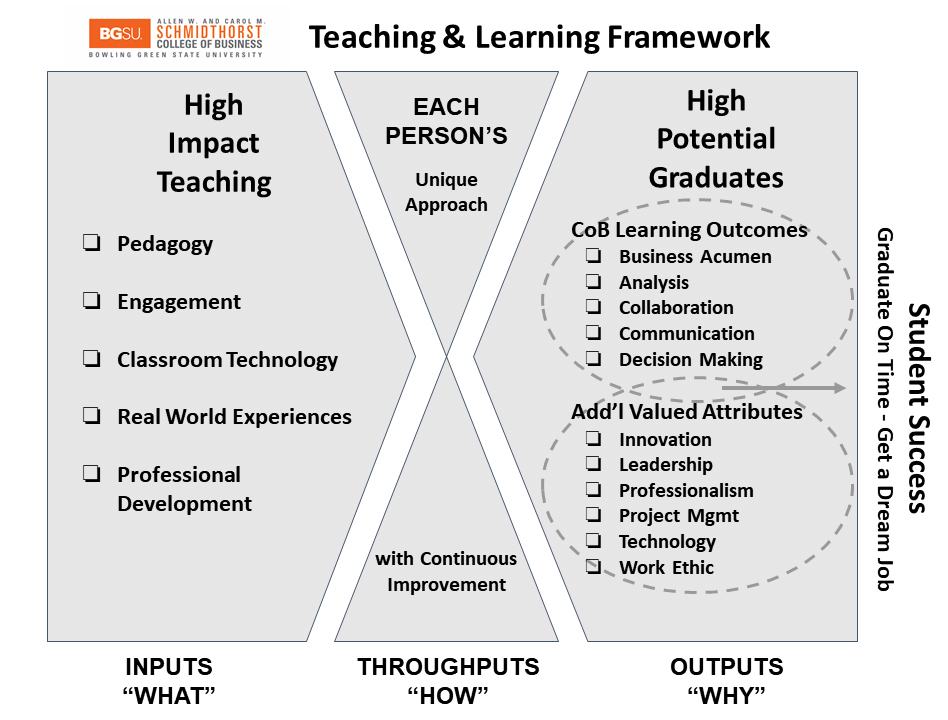Teaching & Learning Framework
The following framework is based on our collaborative work with the college community over a past five year period: all-college meetings, learning events, qualitative data gathering, surveys, and design sessions. CATL’s charge was to collaboratively develop a program that facilitates, promotes, and rewards effective teaching and learning while encouraging each person to teach in their own unique way. Additional details on the results of the research and framework can be found in "Distance Learning: The Top 10 Practices" published in AACSB BizEd.
We conducted a survey on the framework below, receiving 97 responses. There was an 81% overall agreement that the items included are important to very important. CATL met and crafted the following college teaching and learning framework.

Schmidthorst College of Business Proud Graduates
The 10 Success Attributes
As we advance each student’s competencies in business knowledge and its applications, our proud graduates exhibit the following success attributes. These are the ten attributes of graduates who make a meaningful contribution achieving career success in their profession of choice.
| Title | Our Graduates... |
| Analysis | apply their analytical skills to understand situations, solve problems, innovate ideas, and evaluate impact. |
| Collaboration | use their interpersonal skills and tactfulness to relate well with others and work effectively in teams. |
| Communication | effectively communicate verbally and in writing. |
| Decision Making | solve problems and make ethically effective decisions. |
| Innovation | exhibit the creativity and flexibility necessary to adapt to the unexpected and take appropriate risks. |
| Leadership | lead with a strategic mindset. |
| Professionalism |
dress professionally, exhibiting proper etiquette and appropriate behaviors. |
| Project Management | organize and apply project management in order to get things done in a timely manner. |
| Technology | utilize leading edge technologies, devices, and techniques. |
| Work Ethic | pay attention to the details and do the hard work necessary to proactively follow through on their commitments. |
Schmidthorst College of Business Educational Experience
5 Teaching Activities that Drive High Impact Learning
The student learning experience is wholistic, in that learning occurs inside and outside the classroom over time. Our faculty, staff, administrators, and partners play an important role in the learning environment. The following drivers outline the five characteristics of a highly impactful learning experience.
Pedagogy - Students experience enduring learning when instructors challenge students to actively solve problems through purposeful assignments and timely feedback.
- Provide timely feedback on assessments, aligned with learning outcomes and course content.
- Establish clear expectations and instructions for courses and assignments.
- Create challenging group projects, experiential learning, and active learning experiences.
Engagement - Students come to class prepared and ready to learn when they engage with a dedicated instructor that connects the learning outcomes to the student’s personal and professional goals.
- Connect learning outcomes connected to professional and personal goals.
- Implement classroom activities modeled by the instructor’s enthusiasm for the course content.
- Offer mentoring, coaching, and connecting with an approachable instructor.
Classroom Technology - Students effectively participate in class when they use the various teaching support technologies provided online and in the classroom.
- Integrate and leverage the University's learning management system (Canvas).
- Utilize available classroom tools and technology to promote active learning (onsite & online).
- Reinforce the availability of mobile access to the course through different devices.
Real World Experiences - Students passionately commit to their class, degree program, and professional goals when they engage with relevant “real world” opportunities and competitions.
- Encourage participation in relevant internships/co-ops.
- Expose students to real world experience through site visits, tours, guest speakers, or university sponsored international trips.
- Assign class projects, including service learning project-based applications, and case competitions.
Professional Development - Students impress those who are considering them for their next career move when they are provided with customized personal and professional development.
- Promote the development of personal growth and life skills, along with interviewing and career management skills training.
- Foster developmental opportunities through networking, extracurricular activities, and research projects.
- Give students the support and tools necessary to craft an informed career plan that connects their degree to professional and personal goals.
Updated: 03/15/2023 09:00AM
